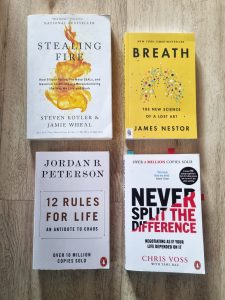
But unfortunately, they still had to be written. If I am being honest, this list should be much longer. While writing the book reviews, books kept adding themselves to the list, so you can find part two here.
Table of Content:
- „12 Rules for Life: An Antidote to Chaos„ by Jordan B. Peterson
- „Breath“ by James Nestor
- „Never split the Difference: Negotiating as if your life depends on it“ by Chris Voss
- „Stealing Fire: How Silicon Valley, the Navy Seals, and Maverick Scientists are Revolutionizing the Way We Live and Work“ by Steven Kotler and Jamie Wheal
- „Thinking, Fast and Slow“ by D. Kahneman
12 Rules for Life
Let’s take a deep dive into „12 Rules for Life: An Antidote to Chaos“ by Jordan Peterson. I got this book years after it was first published, as a gift. It’s one of those books that you can skip through, pick out a chapter or a page, read for a while and reflect on the content and your thoughts about it. I indulged myself into deep discussions with my sister in law, and some other friends in my closest circle and we shared personal experiences and client stories about the various topics covered in this modern classic.
Thinking back to my own 20 yo self, the guidance and rational logic the book provides would have saved me a whole flood of tears and struggles…
Book Overview:
12 Rules for Life is a self-help book structured around twelve fundamental principles that Peterson believes can help individuals bring order to their lives amidst the inherent chaos of existence. Drawing from his background as a clinical psychologist, Peterson integrates philosophy, psychology, mythology, and religion, offering both practical advice and existential reflection. His rules, such as „Stand up straight with your shoulders back“ and „Tell the truth—or, at least, don’t lie,“ are presented alongside anecdotes from his life and clinical practice.
Readability: ⭐⭐⭐ (3/5)
Peterson’s writing oscillates between straightforward and dense, mixing accessible language with complex philosophical ideas. If you are not a native or advanced English speaker/reader, you might struggle a bit more with this one. For some readers, this blend of psychology, mythology, and moral philosophy may feel inspiring, but feel convoluted for others. The book’s tone can shift from conversational to academic, which might slow the pace for casual readers.
Practicality: ⭐⭐⭐⭐ (4/5)
The rules in this book are broad life principles rather than step-by-step instructions, which might appeal to those looking for general guidance on personal responsibility, discipline, and living a meaningful life. However, the lack of precise, actionable exercises could leave readers wanting more in terms of concrete methods for applying the rules. It is one of those books you can grab from its shelve over and overe again, to challenge your own thoughts on specific topics.
Depth of Research: ⭐⭐⭐ (3/5)
Peterson relies heavily on his clinical experience and integrates sources ranging from Nietzsche to Jung, the Bible, and evolutionary biology. Some critics argue that the theoretical basis for his ideas can feel overreaching or loosely connected, especially when he delves into metaphysical territories, such as order vs. chaos. Nonetheless, Peterson’s arguments are rooted in his deep engagement with Western intellectual traditions, although they aren’t always presented with rigorous academic precision.
Engagement: ⭐⭐⭐⭐ (4/5)
Peterson’s passionate tone and willingness to confront difficult, existential topics make this book engaging for readers who enjoy thought-provoking material. His personal stories, particularly about his family and clinical experiences, provide emotional weight. Given his professional background, readers might need to take a break and re-think and reflect on some passages – which I personally find very endearing and thought provoking.
Novelty: ⭐⭐⭐ (3/5)
While the ideas themselves—drawn from myth, philosophy, and psychology—are not necessarily new, Peterson packages them in a way that resonates with modern audiences, especially younger readers struggling with purpose and responsibility. However, critics like The Humanist have pointed out that much of the content feels derivative, a reworking of age-old self-help wisdom with a dramatic flair.
Relevance to Mental Health: ⭐⭐⭐⭐ (4/5)
Peterson’s focus on taking personal responsibility and facing life’s difficulties head-on ties closely to mental health concepts like resilience and self-regulation. His rules encourage self-awareness, discipline, and confronting uncomfortable truths, which are relevant for mental health.
Personally, I love his straight up, no BS approach to topics and marvel at his ability to break down even the hugest pile of crap into manageable steps. I also bought book No. 2 with twelve more rules for life, just because I like his style. BUT for some people out there who need a more sensitive, careful and slow aproach to their life discrepancies, he might not be the best fit.
Truth be told, it wasn’t the book that got me interested in Mr. Peterson, but one of his long-form interviews on the Diary of a CEO. Check out the video below.
Includes Exercises: ⭐⭐⭐ (3/5)
Although 12 Rules for Life provides general principles for improving one’s life, it lacks structured exercises or practical steps for readers to implement those principles directly. Readers are left to interpret and apply the rules on their own, which might work for some but could leave others wanting more specific guidance. If you are fairly experiences with personal development, you should do just fine!
Welcome to the next book topic.
Breath: The New Science of a Lost Art“ by James Nestor
Overview:
In Breath, Nestor explores how modern humans have lost the ability to breathe correctly, which has contributed to a range of health issues—from sleep apnea to anxiety. Drawing on ancient techniques and modern scientific research, Nestor argues that proper breathing, particularly through the nose, can significantly improve physical and mental health. The book blends scientific findings with Nestor’s personal experiences, including experimental studies on mouth breathing and ancient breathing practices.
Readability: ⭐⭐⭐⭐ (4/5)
Nestor presents a highly readable narrative, filled with engaging personal anecdotes, but with some dense sections about breathing physiology that might slow down less technical readers. Overall, the storytelling keeps the scientific content accessible to a general audience.
Practicality: ⭐⭐⭐⭐⭐ (5/5)
The book provides actionable insights on breathing techniques, many of which are easy to implement in daily life. These include nasal breathing and practices like pranayama and the 5.5-second breathing technique. The practical applications are immediate and accessible, and readers can start experimenting with these methods while reading.
You might not be aware of it, but your lungs are the only inner organ you can (semi-) control by sheer will. They will work on autopilot most of the time, but you can hold your breath if you want to. Your breathing is also closely linked to your inner stress levels. Learning how to utilize your breathing is an essential part of learning how to live a healthier life.
Depth of Research: ⭐⭐⭐⭐ (4/5)
While Breath cites numerous studies and medical professionals, some critiques argue that the book lacks deep engagement with rigorous, peer-reviewed science. Nestor heavily relies on anecdotal evidence and personal experiences alongside scientific studies, which can leave some claims feeling under-supported by hard data. Overall, the data provided is of higher standard and way less delulu than in other, more spiritually based books on the subject, so I would always recommend it as a place to start, if you want to learn about the meaning and relevance of Breathing for your life.
Engagement: ⭐⭐⭐⭐ (4/5)
Nestor keeps readers interested by weaving together history, modern science, and personal stories. However, some readers may find that the book loses momentum in its middle sections, as the technical details about breathing may feel repetitive.
Novelty: ⭐⭐⭐⭐ (4/5)
While breathwork itself is an ancient practice, Nestor brings new life to the topic by combining modern science with forgotten wisdom. The book is notable for reviving public interest in an often-overlooked aspect of health.
Relevance to Mental Health: ⭐⭐⭐⭐ (4/5)
The book makes strong connections between breathing and mental health, particularly around reducing stress and anxiety. Nestor shows how controlled breathing techniques can have immediate effects on mood and well-being, making it highly relevant for mental health practices.
Includes Exercises: ⭐⭐⭐⭐⭐ (5/5)
Breath is packed with practical breathing exercises, from simple nose-breathing techniques to more advanced methods like Sudarshan Kriya. These exercises are presented clearly and can be incorporated into daily routines with ease.
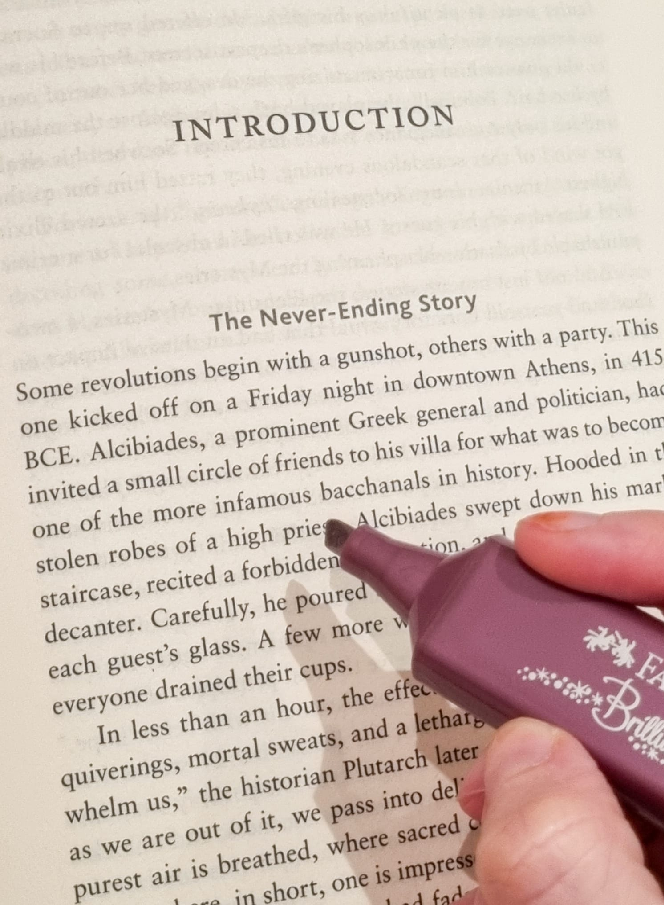
Stealing Fire
Let’s begin with an analysis of „Stealing Fire“ by Steven Kotler and Jamie Wheal. I think I heard about this one and also „Never split the difference“ on an instagram reel and when I looked them up, they sure were instant buys. Starting „Stealing fire“, it was a glimmer moment right away. When a book starts with a phrase that hooks my ADHD brain for weeks, it must be a keeper.
Here is the first line: „Some revolutions begin with a gunshot, others with a party.“ Ohhhh I love this! It’s not linked to nature or anything, but it makes me feel all warm and fuzzy inside, so I count it as a glimmer moment. My friend calls it wordgasms, and I would lie if I didnt appreciate this kind of neologism.
Needless to say that this is a brilliant hook, but it also very, very true. Not all change starts with a traumatic crash or negative event. But they all start with a decision made – and I love that thought. Because you can start (over) at any point in your life, right? I was ready to dive right in.
Can we also all agree on the fact, that a book that introduces the story behind its title in the first chapter has been lectured and thought through very well? This is also the case for this book. Because there was a party going on where someone stole from the priests in 415 BCE, and the title reaches even further back into Greek mythology, when Prometheus stole the first fire and gave it to the humans. Talk about a grand scheme of revolutions here!
Book Overview:
„Stealing Fire“ explores altered states of consciousness (ASCs), known as „ecstasis,“ and how they can be used to enhance human performance, creativity, and problem-solving. The authors delve into how individuals—from Navy SEALs to Silicon Valley pioneers—leverage these peak states for heightened innovation and productivity, and how you can, too. By tapping into cutting-edge psychology, neurobiology, pharmacology, and technology, the book presents a blueprint for unlocking extraordinary human potential.
Readability: ⭐⭐⭐⭐ (4/5)
The book is fairly accessible despite tackling complex subjects such as neuroscience and altered states of consciousness. The authors strike a balance between scientific rigor and engaging storytelling, making advanced topics approachable for a general audience. However, the jargon-heavy content, particularly around flow states and consciousness, might require occasional re-reads for those unfamiliar with the subject.
Practicality: ⭐⭐⭐⭐ (4/5)
„Stealing Fire“ offers practical insights into achieving heightened mental states, advocating methods like meditation, extreme sports, and even controlled use of psychedelics. No, I do not want to get you hooked on drugs. I DO want to get you interested in how to physiologically level up your bodies capacities to achieve extraordinary things AND stay healthy. The book provides useful techniques for incorporating flow into daily life but falls short in terms of structured exercises or detailed step-by-step approaches that some readers might expect.
Here is an example: „Think of yourself as a colander – a bowl filled with holes. When you experience a peak state, it’s like turning on the kitchen faucet and flooding that colander with water. If there’s enough volume, the colander fills up despite the leaks. As long as the water keeps flooding in, you will, for a moment, experience whats it’s like to be a cup. You’ll feel whole; if you’re really inspired, holy.“ (p.205)
Now, a good analogy can go a very long way, right? If you are already used to not only read books like this, but create your own ideas and follow-up exercises from this, you will adore this book.
Because, if we follow through with this analogy, and the water stops flowing, it will pour out of you and you might feel empty, running dry. Of course you want the water back flooding you again, because it felt so good – but that’s not how life nor business works.
Depth of Research: ⭐⭐⭐⭐⭐ (5/5)
The book draws on extensive interdisciplinary research from neuroscience, psychology, pharmacology, and more. The authors conducted years of investigation, speaking with leaders in diverse fields. However, there’s a healthy critique of how some of the scientific evidence on ASCs is still emerging and not always conclusive. Add to that the fact that there are only few meta studies included and the whole thing is more focused on a qualitative research based approach. Doesn’t make it a bad book, though.
Engagement: ⭐⭐⭐⭐ (4/5)
The narrative-driven format, with real-life examples from elite performers, keeps the book engaging. Stories from Silicon Valley and SEAL Team Six, as well as anecdotes about Burning Man and biohacking, add a sense of intrigue. Yet, some readers might find the technical sections dry in comparison to the vivid stories. For me, I don’t mind a very masculine narrative, just please do not expect a cozy, laid-back reading experience.
Novelty: ⭐⭐⭐⭐ (4/5)
While the exploration of altered states and flow isn’t entirely new, the authors present these ideas in an original context by connecting them to modern, high-performance environments. They advocate for the mainstreaming of these practices, which adds a fresh perspective.
Relevance to Mental Health: ⭐⭐⭐ (3/5)
The focus on altered states of consciousness touches on areas relevant to mental health, such as stress reduction and enhanced well-being. However, the book is more about peak performance and less focused on mental health in a therapeutic or clinical sense. To be honest with you – I didnt really care. It was a very interesting, well written read overall.
Includes Exercises: ⭐⭐⭐ (3/5)
Although the book offers strategies for achieving altered states, it lacks structured exercises or a clear „how-to“ section that might help readers systematically integrate these techniques into their lives. There are recommendations but few concrete action steps.
Overall, I would give it a YES again at any time. Although I am not a substance user regularly – I don’t even drink coffee – I found very inspireing stories and anecdotes in here, plus more than a handful of powerful analogies that I can confront myself and my dear clients with.
Never split the difference
„Never Split the Difference“ by Chris Voss
This is one of my Must-Read Books of all times. I have used many of the strategies introduces in this book, both in therapy sessions (to talk somebody down in a life-threatening situation) and for saving money on a car deal. This is a book I have bought 7 times by now, to give to friends and family. I even suggest it to my students, although they might challenge me much harder after reading it.
Overview:
Chris Voss, a former FBI hostage negotiator, applies the techniques he used in high-stakes situations to everyday negotiations. He emphasizes psychological tactics like tactical empathy, mirroring, and calibrated questions, arguing against traditional compromise or „win-win“ approaches.
Readability: ⭐⭐⭐⭐⭐ (5/5)
Voss’s writing is highly accessible, filled with engaging stories from his career. His clear explanations make negotiation strategies easy to understand and apply. This IS one of the books to read on the go, unless you like to take notes. I would have read it in one sitting, if I hadnt have to write 18 pages full of notes on this book.
Practicality: ⭐⭐⭐⭐⭐ (5/5)
This book excels in practicality, offering negotiation techniques that can be applied immediately. Strategies like anchoring, labeling emotions, and using calibrated questions are useful in both professional and personal scenarios. Yes, he will give you the exact phrases to use. Even for you own email marketing, research or network building. It’s impressive, really.
Depth of Research: ⭐⭐⭐⭐ (4/5)
While not as academically rigorous as Kahneman’s work, Voss draws from psychological principles and real-world experience. His advice is backed by practical knowledge gained from years of FBI negotiations. Funny enough, he cites research done by researches that makes you rethink the relevance of old techniques to force somebody to say „Yes“ – often enough, he proves them wrong. He debates his way to top notch strategies that work and build connection, rather than kill it.
Engagement: ⭐⭐⭐⭐⭐ (5/5)
The real-life examples, especially from hostage negotiations, make the book exciting and compelling. Readers are drawn into the high-stakes world of negotiation while learning useful skills.
Novelty: ⭐⭐⭐⭐⭐ (5/5)
Voss introduces a new way of thinking about negotiation, that is even taught at high-end FBI academies. Techniques have been tried and tested both in crisis and everyday-life-situations. They are based on Jungs psychology and many other great minds. Voss is challenging conventional tactics like compromise and „win-win.“ And heÄs got a point. If you want your husband to wear brown shoes and he wants to wear the blue ones – the compromise would be one blue, one brown. That would obviously be the worst outcome here. His focus on emotional intelligence and manipulation of cognitive biases feels fresh and innovative.
Relevance to Mental Health: ⭐⭐⭐⭐ (4/5)
Though the book isn’t about mental health, its focus on empathy, listening, and emotional control has valuable mental health applications. These skills help improve communication and reduce conflict. If you have ever been scammed before, you might recognize some of their techniques – or you might read this book to feel empowered to meet the next sleazy sales person who doesn’t have your best interest at heart. Hopefully, none of us will ever have to talk a kidnapper or a person in a mental health crysis down… but the techniques would help with that, too.
Includes Exercises: ⭐⭐⭐⭐ (4/5)
Although the book often includes little advertisers for the authors other programs and reflects back on classes he has given, there is also a ton of practical advice to practice with. E.g. you can learn and apply techniques on how to negotiate – and overall communicate – better. This is especially true for situations that might feel stressful or unnerving for many. Like a job interview or an appointment to discuss a raise at work.
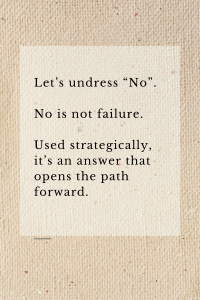
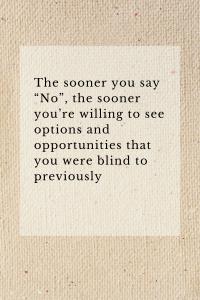
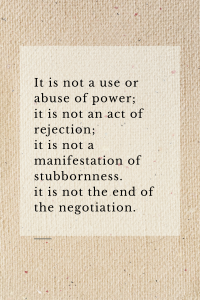
Favorite quotes from „Never split the difference“ (p. 88). Now tell me thats not of therapeutical value… although it is used in the context of a negotiation. Tweaking wise words for your own journey you are on – is that a good thing, or not? How do you do it?
„Thinking, Fast and Slow“ by Daniel Kahneman
Overview:
This book introduces two cognitive systems that drive our thinking. System 1 is fast, intuitive, and emotional, while System 2 is slower, more deliberate, and logical. Kahneman’s groundbreaking research shows how these systems interact and influence our decision-making, revealing the cognitive biases that often lead us astray.
Readability: ⭐⭐⭐ (3/5)
While Kahneman simplifies complex psychological ideas, the book can feel dense due to the depth of content and scientific studies. For readers with little background in psychology, it might take effort to fully grasp the ideas.
Practicality: ⭐⭐⭐⭐ (4/5)
Although primarily theoretical, the book provides practical insights into how we can avoid common cognitive errors. Kahneman teaches readers to slow down and engage System 2 for better decision-making, especially in high-stakes situations.
Depth of Research: ⭐⭐⭐⭐⭐ (5/5)
This book is a culmination of decades of Kahneman’s Nobel Prize-winning research in psychology and behavioral economics, offering an in-depth look at how cognitive biases shape human behavior. What more can I say?!
Engagement: ⭐⭐⭐⭐ (4/5)
Despite the technical nature of some chapters, Kahneman’s use of real-world examples, including his work with Amos Tversky, keeps readers engaged. His exploration of concepts like the peak-end rule and loss aversion is particularly memorable. You might wanna join a discussion group on this book, to get the best benefits from reading it. And never forget to take notes to reflect on later.
Novelty: ⭐⭐⭐⭐⭐ (5/5)
Kahneman revolutionized how we think about human decision-making, debunking the myth of humans as purely rational actors. His introduction of concepts like anchoring and the conflict between our experiencing and remembering selves adds original insight.
Relevance to Mental Health: ⭐⭐⭐⭐ (4/5)
While the book is not directly about mental health, it highlights how cognitive biases can affect decision-making and emotional well-being. Learning to recognize and mitigate these biases can be beneficial in stress management and personal growth. If you have ever struggled with mental overload, decision-making-fatique or just struggeling with making decisions overall, this is the book for you – at least, if you can focus long and hard enough
Includes Exercises: ⭐⭐ (2/5)
Kahneman doesn’t include explicit exercises, but his insights encourage readers to reflect on their thinking processes. It’s more about awareness than structured self-help.
If you are interested in other books that dive deep into the brains cognitive functions, these books might also be a good choice. I cannot put into words the delight I feel when I remember how hard it was go get stuff like this in your hands – and how accessible it is now.
Comparable Books:
- „Predictably Irrational“ by Dan Ariely – Explores cognitive biases and decision-making errors.
- „Nudge“ by Richard Thaler and Cass Sunstein – Focuses on behavioral economics and how we can „nudge“ people towards better decisions.
- „The Undoing Project“ by Michael Lewis – Chronicles the partnership between Kahneman and Tversky and their work in behavioral economics.
Would you agree on this list? Any other non-fiction books that are a MUST-READ in your life? Let me know in the comments!
You can find part 2 of books I wished I could have read in my 20s here.
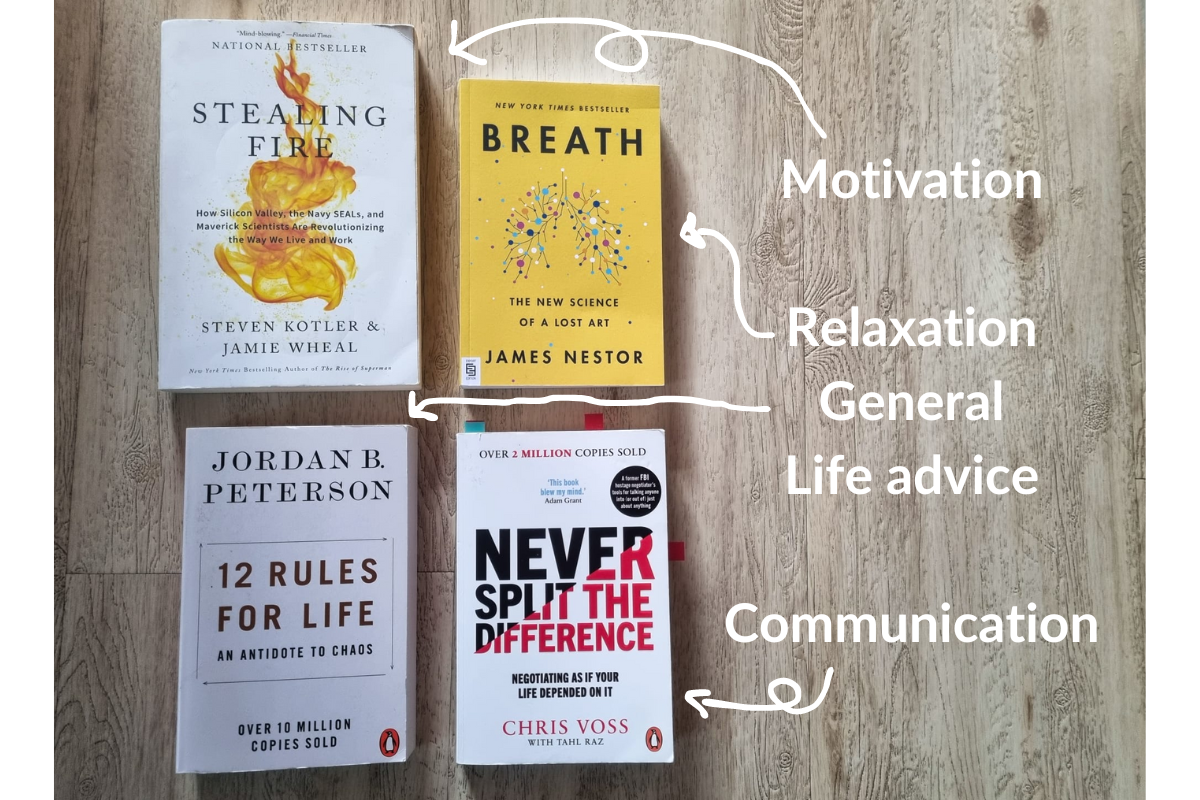
No responses yet